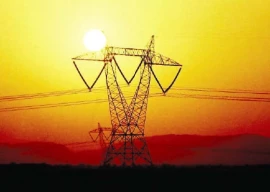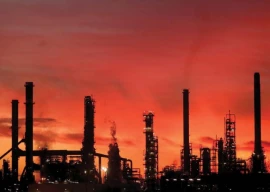
President Asif Ali Zardari’s state visit to Dushanbe, to meet with the heads of state of Tajikistan, Afghanistan and Iran may be one of the most consequential of his presidency. With Pakistan’s energy crisis becoming ever more grave, the need for power has never been more acute. It was heartening, then, that the president insisted that Pakistan would go ahead with both the Iran gas pipeline and the Turkmenistan-Afghanistan-Pakistan-India (TAPI) pipeline. As welcome as these words are, there is every chance that they will collide with the immovable forces of superpower politics and the threat of militancy. Of the two proposed pipeline projects, the Iran gas pipeline is by far the more viable option. It is more affordable than the TAPI pipeline and also faces less threat of being blown up by extremists. The TAPI pipeline would run through Herat and Kandahar in Afghanistan and Quetta in Pakistan, which makes the chances of sabotage more of a certainty than a possibility.
The Iran pipeline, on the other hand, faces the equally deadly American veto. The US, through Secretary of State Hillary Clinton, has already floated the threat of sanctions should Pakistan go through with the proposal. The US has also been making use of back channels to put funding for the project into peril. A Chinese bank withdrew its promise of money for the pipeline after quiet US intervention. Now, if the two countries want to continue with the pipeline, they will have to come up with the funding themselves. So given how essential the pipeline is for Pakistan’s future, it is time we call America’s bluff and ensure the project is completed.
Presently, Pakistan is facing a gas shortage of one billion cubic feet per day and, short of massive price increases that would more than double the cost of gas to consumers, the only way to meet the demand is through these pipelines. Once the gas pipelines are functional, the TAPI pipeline is estimated to allow Pakistan the import of 10 billion cubic metres of gas every year, while the Iran pipeline would facilitate the import of one billion cubic feet per day. The Americans might threaten to shut off the aid spigot, but this is one occasion where we need to keep our long-term interests in mind, even if they lead to a clash with Washington.
Published in The Express Tribune, March 27th, 2012.
COMMENTS (14)
Comments are moderated and generally will be posted if they are on-topic and not abusive.
For more information, please see our Comments FAQ





























































@ALi:
They will end up with neither and be shocked......
they want civil nuclear technology so they are using this IP gas line as a ace card... Pakistanis are not sincere to IP gasline.
@jamal: "funding shouldnt be a problem. companies like OGDC, PPL, SSGC, SNGPL can form a company and invest in it."
OGDC has already refused to fund the pipe line.
@Sadqay Jawaan:
We are in agreement. If this is in the best interest of PAK then PAK should build it. The only point being made is that this decision like all decisions a nation makes must fit into a much bigger scope of what is in thejr best interests not just for today but long term. That seems to be a problem for PAK in that it has no long term vision.
sell nuclear weapons and spend that amount on Iran-Pak gas pipeline. Anyhow the nuclear weapons are a waste and not useful either to fight India or our own terrorists.
its not a matter of either/or. we are energy starved country. we need energy from any source, TAPI, IP, UAE/Pakistan. all options should be used. funding shouldnt be a problem. companies like OGDC, PPL, SSGC, SNGPL can form a company and invest in it. or the company can issue shares/convertible bonds to general public and institutional investors. dividend/interest from these stocks will also offset common man's gas expenses
. Pakistan needs to Bite the Bullet and Build the Pipe Line. . There is no other alternative. . Cheers
Interetsing...... how can our front line media specially english one has written something to their "godfather the great USA" with this "courageous" tone!!!!!!!!!!!
If my words dont fell on deaf ears: mark these ones;
USA CANNOT DARE TO DO ANYTHING.@Harry Stone: Yah.. Pak will make the decision what its people want. Isn't it the true spirit of democracy? I think it is. Human Right, Civil rights, freedom of expression .. PAK will consider all these slogans and let the people decide. Whatever they will say, Pak should do. Shouldn't it , Mr. Champion of world democracy? I am sure you will agree as no body raises slogans of democracy higher than you do? Right? So, let the people's will Prevail.
@MarkH: Don't waste your time here and go take care of the 211 Billions dollar's fraud in coal mines Business of your politicians. Don't waste our time either. make sure that you recover that money from the Swiss Banks.
There is a price to be paid for every decision. Once it is recognized that Uncle Sam will react negatively, one should face the consequences. Whining later will not prove productive.
Go ahead Pakistan and complete the Iran-Pak pipeline project as quickly as possible. Nation is going through energy crises. People are suffering and running out of their patience. Pak should shun American pressure. As America always see its interests, Pak must see its own interest.
It's not just the US aid you have to worry about - even China has significantly reduced it's import of Iranian crude after the USA made it clear that it was going to punish those who did business with Iran. If China is concerned about the ramifications of doing business with Iran then Pakistan should be terrified.
Fund it and build it if it is in the best interest of PAK. Realize there will be on funds from the IMF, WB, ADB.
The Americans will not threaten to shut off aide they will. Just as they will block PAK every goal in the international arena.
PAK thinks because it has a need it get a pass on making hard decision. Every nation has needs and they have to make hard decisions.
Hopefully PAK will make the right decision and then live with the results of that decision....
Anyone want to do a reset in relations between PAK and the US?